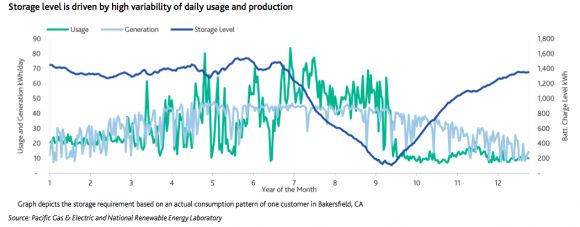Many years ago, utilities awoke to a threat that an industry trade group warned might cause "major disruptions" to electricity supplies.
Worries about the threat ran all the way up to the White House and Congress, where politicians predicted an unraveling of the electric system.
"I think we're no longer at the point of asking whether or not there will be any power disruptions, but we are now forced to ask how severe the disruptions are going to be," said Connecticut Senator Chris Dodd.
No, these warnings were not about a utility death spiral. They were about Y2K, the overhyped doomsday scenario for glitchy computers that never materialized.
A decade and a half later, a new threat is emerging that some predict will throw utilities into turmoil: grid defection.
As solar and batteries become cheaper while electric rates rise, economic models suggest that millions of consumers could decide to sever ties with their utility and go completely off-grid. Under such a scenario, leading utilities could lose millions of customers and investors could lose billions of dollars.
So is grid defection a real risk -- or just another Y2K?
Analysts at the credit rating and research firm Moody's aren't buying the hype. In a new report on solar and storage -- a technology pair that nearly every major investment firm is now modeling -- Moody's calls grid defection a "vague and distant" scenario for utilities.
"We do not foresee grid defection being a material risk to the utility sector because the barriers are currently too great and the probability of an abrupt and unexpected development is too remote," concluded the five utility and credit analysts who collaborated on the report.
They argue that battery technologies are still too expensive and that most consumers aren't psychologically prepared to leave the grid.
Battery costs have fallen more than 50 percent in recent years, but they'll need to fall much further in order to ensure around-the-clock power for consumers. After modeling usage patterns across sixteen cities in California and Hawaii, they concluded that batteries would need to provide power for 63.7 days on average -- adding a cost of 535 cents per kilowatt-hour.
Ravi Manghani, a senior storage analyst at GTM Research, called the 63 days of backup "unheard of."
Why would homes need such big batteries?
The analysts assumed that people would use electricity off-grid like they do while connected to the grid -- erratically. Assuming consumption patterns don't change, the analysts say batteries will need to be an order of magnitude cheaper in order for grid defection to make sense.
"In our view, most grid defection studies published thus far have used broad and somewhat simplistic assumptions about power production and usage patterns based on monthly averages. We believe these substantially understate the amount of storage that is required for grid defection without also making substantial changes to power consumption patterns and lifestyles," wrote the analysts.
The Moody's analysts may be overestimating how many batteries households will need to leave the grid (a typical off-grid home only carries a few days' worth of backup). But much lower battery costs still probably wouldn't be enough to cause grid defection. That's because people are far too dependent on the electric system -- which itself is a giant battery.
The "lifestyle adjustments required will be unacceptable to most people. We believe that most people are too accustomed to the convenience and reliability of grid-supplied electricity and will not accept the constant need to be mindful of the battery charge levels and conserve electricity, as necessary," wrote the analysts.
Even though many people complain about their utilities, very few are likely to separate themselves from the grid -- even if the cost of solar-plus-storage systems fell far below the cost of conventional electricity.
However, utilities have never really been worried about outright grid defection. Rather, they worry about declining revenues as customers consume less electricity and use the grid as backup for their solar or storage systems. States like California, New Jersey and Massachusetts have already seen load growth cut in half by solar PV.
By 2018, GTM Research projects that the U.S. solar-plus-storage market will grow to around 320 megawatts by 2018, led by the commercial market.




